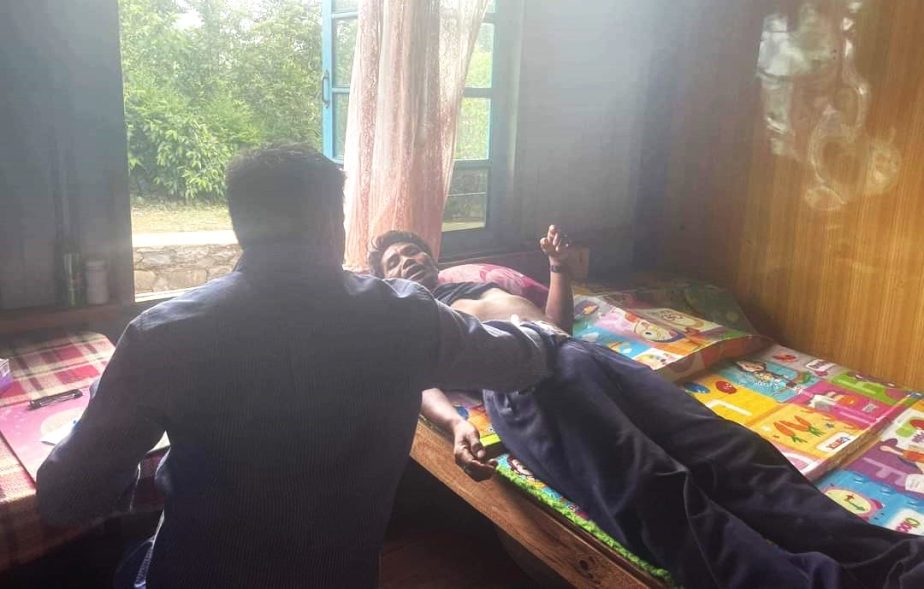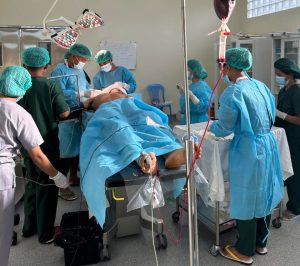The Myanmar junta’s absence from large parts of the country as a result of the ongoing civil war has prompted the opposition National Unity Government (NUG) and resistance groups and individuals aligned with it to fill the vacuum by providing services to citizens in various places across the country.
Among the many doctors and nurses offering medical services to the public, braving the dangers of bombings and ambushes, is an intrepid squad of nine persons from Chin State that has pulled out all stops to treat people where no alternate facilities exist.
The medical team is led by Dr. Amos, a surgeon who formerly working at a government hospital in Yangon. After the military coup on February 1, 2021, protests against the junta erupted and a large number of people joined the Civil Disobedience Movement (CDM). Among them was Amos.
Amos arrived at Thantlang Township in Chin State on September 5 of that year. He gauged that the war would drag on and that the government healthcare infrastructure would be non-functional due to the unrest. Without wasting time, he charted a roadmap to provide health services in Thantlang and assembled a team of three nurses and five volunteers.
“Gathering a team of dedicated people was the easier part of the program,” Amos told The Diplomat over telephone. “The real challenge,” he said was “to create the infrastructure, including a constant flow of medicines and funds.” In the initial months, “the Chinland Defense Force-Thantlang assisted us immensely in our task,” Amos recalled.
The efforts of Amos and his team resulted in the setting up of a small hospital where about 400-500 patients are treated every month. A mobile clinic launched months later ventures occasionally to remote villages for the treatment of patients. The surgeon pointed out that as many as 30,000 people residing in 52 villages are being covered by these twin ventures. The expenses are met through remittances from the Chin expat community and contributions from the Chin Health Organization.

Dr. Amos with a patient at a village in Thantlang in Myanmar’s Chin State. Credit: Dr. Amos
The majority of the patients treated so far were found to be suffering from stomach ailments, appendicitis, bullet injuries, and pregnancy-related issues necessitating Caesarean operations.
Medicines are procured from Mizoram in India, and Mandalay and Kalay in Myanmar, Amos said. But there is a shortage of medicines as “roads are sometimes blocked by the military. Some surgeries require modern anesthetic medicines and to conduct surgeries without these medicines becomes extremely challenging,” he said.
Among the most challenging surgeries that Amos performed was the one he conducted on March 22 of last year, when a resistance fighter in his early 20s arrived at the hospital with multiple bullet wounds. “He had injuries in the abdomen and pancreas that had led to severe loss of blood,” he said.
Amos said he was unsure if the operation would be successful. “It took us four hours but the patient survived,” he said, adding that there have been three such cases since the hospital was established almost two years ago.
According to the Special Advisory Council for Myanmar (SAC-M), an independent group of former U.N. human rights experts, the healthcare sector in Myanmar has suffered massive damage since the coup. About 70 percent of all health workers in the country joined the CDM and went on strike, prompting the military regime to launch crackdowns. According to an estimate by the SAC-M, 30 health workers were killed and 286, including 140 doctors were arrested, with 89 still behind bars as of April 2022.
Like Amos, there are several doctors in other parts of the country who have offered their services in health establishments set up under the NUG. In September of last year, NUG’s Acting President Duwa Lashi La said that out of a total of 330 townships across the country, public administration and judicial systems have been established in 24 townships, which are completely controlled by resistance forces. These include education, health, municipal, and social services facilities. A functionary of a resistance group claimed that seven doctors in Chin State have offered their services for the treatment of the people.
Health facilities offered by the resistance groups were found to be more efficient and consistent in Chin State than in Sagaing Region, which were the two regions I visited early this year over a span of 21 days. According to functionaries of resistance groups, the junta controls around 30 percent of Chin State and close to 50 percent of Sagaing Region.
Nonetheless, irrespective of the areas under its control, all facilities set up by the NUG face the constant danger of being bombed by the regime forces. Amos and his squad are always prepared to relocate to safer places with their equipment and patients whenever the situation demands. They were compelled to vacate the hospital three times over the last year after receiving information from resistance groups about the possibility of a raid by the military.
“On one occasion, the hospital remained shut for a week. There’s a constant danger of bombings. We keep our fingers crossed at all times,” said Amos.

































